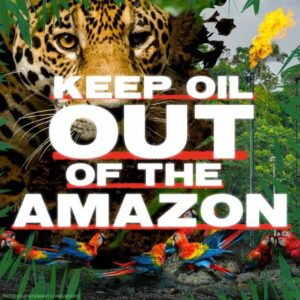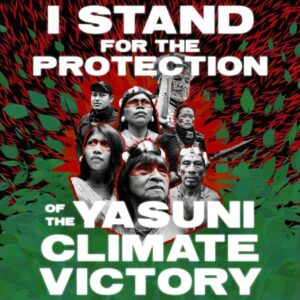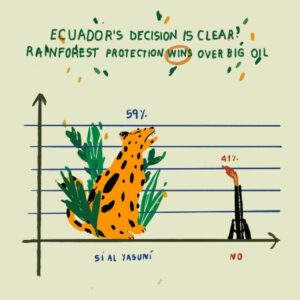
Dioselina Sandoval, a Secoya elder, stood before three judges of the Superior Court of Justice of Loreto, Peru. It was July 2025, and along with a delegation of 20 Indigenous people from Secoya communities, she had finally found herself in a meeting face-to-face with the judges, who could determine whether the rights of Indigenous Peoples in Peru would advance or be set back.
“I come from the depths of the forest. We come seeking justice,” Dioselina said in a soft voice, with a firm gaze. “I am from the forest, I am the forest itself, and I need to continue living there.”
The Secoya-Siekopai are a cross-border Indigenous people who inhabit territories in both Ecuador and Peru. Historically, they were decimated by evangelization and slavery during the rubber boom, and today, the State continues to neglect them. This has led them to wage a long struggle to be recognized as owners of their ancestral territories and to achieve legal security.
In December 2021, the communities of Mashunta, San Martín de Porres, and Vencedor-Wajoya filed a lawsuit before the Court in El Estrecho, Putumayo, Peru. The communities sued the Peruvian State to demand full possession of their ancestral territory. Almost three years later, in October 2024, the judge issued a ruling recognizing the Secoya people’s ancestral status over the territory they claimed. The Court ordered the Regional Government of Loreto to grant them the full title to nearly half a million acres of forest.
This type of legal victory is not common; the current national land titling system in Peru is discriminatory and unconstitutional. Under the Forestry Law, the Peruvian State decides how land is used based on its economic utility, classifying land according to its suitability for agriculture, livestock, and/or forestry.
Under this criterion, Indigenous Peoples only have the right to possess land that is considered suitable for agriculture and livestock. The land that is “suitable for forestry” is under the legal category of “cesión de uso,” meaning it is essentially a loan from the State that can be revoked at any time. This puts communities at risk of being dispossessed of their territories. Up to 80% of the Secoya communities’ ancestral territory is under the “cesión de uso” legal scheme, meaning the State does not recognize the community as the ancestral owners and guardians of the land.
“We did not come here from somewhere else; this has always been our territory,” says Anselmo Sandoval, a Secoya leader who has led the lawsuit since its inception. “They treat us as if we are on borrowed territory—us, an ancient people.”
This system, in addition to being unconstitutional, contradicts international law because it excludes Indigenous communities from property titles to forested and/or protected areas. The State’s treatment of Indigenous communities through this system is expressly prohibited by international treaties such as Convention 169 of the International Labor Organization (ILO).
According to Juan Carlos Ruiz Molleda, a lawyer with the IDL (Instituto de Defensa Legal, or Institute for Legal Defense), approximately 90% of the territory in the Peruvian Amazon is suitable for forestry. This puts 2,500 Indigenous communities in peril. The Secoya-Siekopai are a people at risk of cultural and physical extinction, with a population of just 2,000 people between both of their countries (800 in Ecuador and 1,200 in Peru). The struggle for the recovery and reunification of their territory is being carried out on both sides of the border; it is a struggle to continue living in their home and to maintain their identity as Secoya-Siekopai. Once ratified, this ruling will be key to the community’s survival, as well as that of many other Indigenous Peoples.
The Peruvian State has a historic opportunity to shift its approach toward ancestral territories from one based on economic productivity to one based on respect and recognition. However, the legal process for securing the title to these nearly half a million acres of forest is not complete. Several state institutions involved in the process appealed the judge’s decision, and the case is now in the hands of the Superior Court of Justice of Loreto (CSJL).
“This is the first time in Peru that there has been a ruling of this type to protect land tenure through the recognition of historical ties,” says Jorge Acero. Acero is a human rights defender at Amazon Frontlines, an organization that closely monitors the Secoya-Siekopai’s territorial recovery and formalization processes. He explains that “the State’s job is to verify that these people are the historical owners of the land, and after doing that, to deliver land titles for their legal security.”
On May 17, 2025, the CSJL set the date of a hearing regarding the Secoya’s territory for May 26th. That gave the community just nine days to notify its members, prepare, and undertake the three-day trip to Iquitos to attend the hearing and be heard; it was not enough time. So, the Secoya Indigenous Organization of Peru (OISPE) and the Legal Defense Institute (IDL), an allied organization providing technical and legal support, asked that the judges postpone the hearing. The request was denied, and the hearing was held virtually.
On July 11, 2025, a Secoya delegation, which included Dioselina, arrived at the Court in the city of Iquitos, seeking an in-person meeting. Judges Chabela Carrión, Betty Magallanes, and Sergio del Águila welcomed and listened to the delegation. Dioselina spoke to them about the pottery she made with her own hands and with elements obtained deep in her territory, in the Amazon rainforest. The clay, the roots, and the plants used to create the color are unique to her territory, and their production is part of the ancestral knowledge of the Secoya-Siekopai, passed down from generation to generation.
After the meeting, the Court announced that a ruling will be issued in August 2025.
Apu* Edinson Cabrera Sandoval, president of the OISPE, has confidence in the Peruvian justice system. He hopes the judges understand that “our use of the territory is comprehensive.”
“It is not separate, divided into categories of productive areas, as the ministry sees it,” he says. “It is connected to everything.”
This confidence in the CSJL is rooted in a ruling issued by the same chamber in 2024 recognizing the Marañón River and its tributaries as legal subjects with rights, a groundbreaking decision that made history in Peru and throughout Latin America.
If the judges of the Superior Court of Justice uphold the ruling from October 2024 in the Secoya Case, they will once again make history. Their ruling can advance the recognition of the rights of Indigenous Peoples and strengthen the protection of a territory in the Amazon that is key to global climate regulation.
* “Apu” is the respectful way of addressing an Indigenous leader in Peru.




